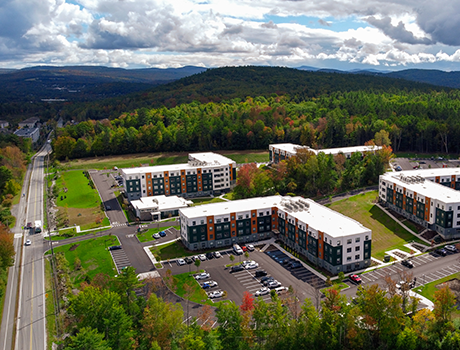As housing costs rise, colleges, universities and developers are teaming up to address a widening affordability gap at their campuses by making housing available and attainable for the population that needs it.

The Michaels Organization
One of the developers leading this charge is The Michaels Organization, which is applying lessons learned in its 50 years of affordable housing development to create student housing dedicated to serving students, faculty and staff who would struggle to pay market rent. Student Housing Business queried Ned Williams, executive vice president of development at The Michaels Organization, about how the company keeps development costs down so these hybrid properties can operate at below-market rent and still maximize occupancy.
In Williams’ experience, a campus’ graduate student population is most likely to struggle with housing costs. It’s no surprise that most of The Michaels Organization’s recent attainable student housing projects are earmarked to serve this group.
“Graduate students are probably the most financially stressed cohort of the university,” he says. “They aren’t on mom and dad’s payroll; they work too much at the school to have a full-time job elsewhere and they may be living on a teaching stipend or part-time work. Finding market-rate housing for them is almost impossible, so we are working with these institutions to provide what is basically workforce housing for their graduate students.”
Attainable housing, as The Michaels Organization describes its affordable student housing units, can also serve faculty and staff who fit a project’s income parameters. The University of California, Davis, for example, worked with The Michaels Organization to develop an attainable student housing project that also serves school staffers with families. Alternatively, an attainable graduate housing property with vacant units may find entry-level faculty members eager to lease the remaining units.
Multifaceted Cost Control
As with conventional workforce housing, an attainable student housing developer must reduce overall project costs to allow a positive cash flow with below-market rental income. The Michaels Organization focuses its search for savings on three major cost centers:
Cost-effective land: A college or university can eliminate a significant development expense by donating a building site or agreeing to a long-term ground lease at a reasonable rate. “Land acquisition is normally 10 percent to 20 percent of development cost, so taking land out of the equation helps the developer offer below-market rents,” Williams says.
In a traditional multifamily example that may inform student housing efforts in the near future, Disney is working with The Michaels Organization to offer low-rent housing to employees of Walt Disney World in Florida. Disney provided the site on a long-term ground lease at zero cost. “They are not making a penny on the ground lease because it gives them a tangible way of giving back to the community,” Williams says.
Tax abatements: Public-private partnerships can play a vital role in achieving housing affordability, and tax relief is one of the most profound contributions governments can make to foster housing that will be within reach for a targeted segment of renters.
With student housing, developers should expand their cost analysis to take best advantage of a state-supported school’s tax-exempt status. If the college or university is privately owned, consider establishing a nonprofit entity to hold the property or ground lease, if applicable.
Robust infrastructure: A student housing community must have adequate utilities, transportation and community amenities. Developers should be sure to research available services and connectivity before committing to a site. They should look for ways to meet project needs through partners and contributions to minimize costly offsite work.
In Steamboat Springs, Colorado, where The Michaels Organization is developing workforce housing in partnership with the Yampa Valley Housing Authority, utility connections already exist, which provides significant savings to the project.
Design Considerations
Even after maximizing project savings related to land cost, tax abatements and infrastructure, a student housing project still needs to attract and retain renters by providing a desirable resident experience. The developer’s goal should be to focus on low-cost, high-return building features that don’t simply run up a project’s price tag.

Design features that appeal to graduate students include large common areas and meeting rooms to accommodate a dozen people or more, since grad students tend to socialize and collaborate in larger groups than do undergraduates. Graduate students and faculty typically get along well as neighbors, Willliams adds, but mixing grad students and undergraduates in the same property can lead to conflicts over noise and other disruptions.
Williams suggests letting topography suggest amenities. For example, at one of The Michaels Organization’s student housing developments in California, Michaels plans to take advantage of the development’s hillside location to incorporate a rooftop amenity deck into the design. “Green roofs and decking can give residents great views and meeting spaces that don’t require a sacrifice of interior building space,” Williams says. “We look for opportunities that the building and exterior spaces give us to create amenities.”
Developers don’t need to invest in elaborate amenities for affordable-rate student housing, Williams says. Today’s marketable features include access control systems to keep residents safe.
“The good news is that in market studies, students are saying they don’t care about having a coffee shop kiosk and tanning beds like they did a few years ago,” Williams says. “They would rather forgo those amenities if it takes $20 of their monthly rent.”
— By Matt Hudgins. This article was written in conjunction with The Michaels Organization, a content partner of Student Housing Business.
To learn more about The Michaels Organization, click here.
For more information on becoming a Student Housing Business content partner, contact Rich Kelley, publisher, or Tim Tolton, media advisor.


